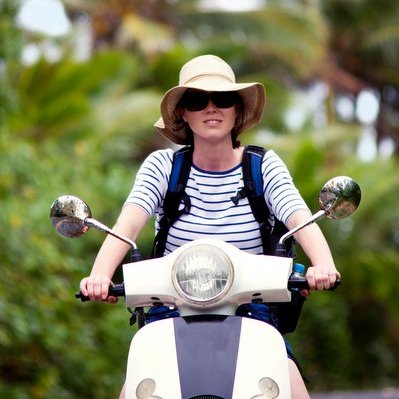Fancy getting paid to travel the world as a travel blogger? Of course you do!
Today, there are more travellers than ever living a digital nomad lifestyle and funding their travels with a profitable travel blog.
But how do they do it? How could you do it, too?
After all, it’s one thing to write about your travels, but it’s quite another to turn your words into cold, hard cash.
If you want to turn your travel blog from a hobby into a business, it’s not easy, but it’s possible. Here’s how to build a strong foundation for success in 7 simple steps:
Step 1: Make a commitment
If you want your travel blog to make money, you have to commit to running your blog like a business. That means hard work, long hours, and sacrifices – even while you’re travelling.
Yes, you’ll get to enjoy incredible travel perks and visit amazing destinations, but you’ll also have to spend a large portion of your time cooped up in hotel rooms chained to your laptop.
If the reality part of travel blogging sounds like a drag, get out before you begin – the competition is too steep if you’re not willing to commit 100%.
Step 2: Choose a niche
Still in? Cool, cuz it’ll all be worth it when the perks (free hotel rooms, press trips, airfare upgrades) start rolling in.
First thing’s first – let’s choose your niche. You can’t be all things to all people, and you’re sure to get drowned out if you try. That’s why the most successful (read: profitable) travel blogs cater to a highly specific audience of travellers.
Choosing to blog about “budget travel” or “luxury travel” is great, but try and get more specific.
- Instead of creating a family travel blog, focus on parents of children under age two.
- Instead of luxury travel blog, create content for upscale female business travellers in their 40s and 50s.
- Instead of a budget travel blog, focus on underserved travel niches like long-term travel, career break travel, or solo travel.
Don’t be afraid to get this specific. Choosing a narrow niche allows you to easily find your audience, become known for one specific thing, and make strong, instant connections with the people who will become your fans, followers, and paying customers.
Go deep in order to stand out, then broaden your efforts and appeal to a wider audience once you’ve made a name for yourself.
Step 3: Build an email list
If Twitter went belly up tomorrow, how would you contact all of your followers? The truth is you’d lose them all – unless you had their email address.
Email?! Sounds a little old-timey, right?
Hate to break it to ya, but so does blogging!
But just like blogging, email marketing has stood the test of time and remained a powerful online force to be reckoned with, even in the age of social media.
Why? Well…
- When you post on social media, it’s well known that your content is being seen by hundreds or thousands of other people. There’s nothing personal about it, and it can be easily dismissed as “not for me.”
- Unlike social, an email message lands in someone’s personal inbox, right next to their work emails and messages from family and friends. Because of this, email is inherently more personal than social media, and therefore more effective at building connections.
- Email allows you to drive traffic to your website, but it also helps you create and deliver effective marketing campaigns that drive sales (yes, you do have something to sell. We’ll get to that in step #5).
- Email is the most cost-effective form of online marketing.
Step 4: Be strategic with social media
Many newbie travel bloggers waste countless hours trying to build a presence on social media – on every single existing platform. Unless you have the budget to hire a full time social media staff, this is an ineffective strategy that costs you time and money.
Instead, figure out where your target audience hangs out on social and target them with laser focus.
- Are you targeting budget backpackers in their early 20s? Focus on building a Snapchat following.
- Are you targeting Baby Boomer retirees? Try Facebook.
- Want to connect with influencers in the travel space? Twitter may be your best bet.
Focus on building an engaged, loyal following on 1-2 social platforms, then expand from there (and don’t forget to get their email addresses!).
Step 5: Have something to sell
You weren’t planning on monetizing your travel blog with Google AdWords, were you? Tsk, tsk, tsk. While advertising is certainly one way to monetize a website, it’s not the most efficient way – especially when you’re first getting started. You’ll need a ton of traffic for AdWords to pay off, and a ton of traffic for travel businesses or other bloggers to want to advertise on your site. And that can take months, or even years.
In the meantime, have something tangible to sell.
- Create a travel course.
- Sell an informative eBook.
- Develop paid webinars.
- Publish an infoproduct.
Make your offering affordable (under $100) and highly valuable for your audience. Offer it to your email subscribers and social followers after you’ve earned their trust with great free content.
Step 6: Pursue joint ventures
Mutually beneficial relationships.
Why build your travel blog from scratch, when your audience already exists? There are plenty of other travel bloggers already writing within your niche, targeting exactly who you want to target. Reach out to them via social and find a way to provide value to them.
Offer to guest blog on their site for free, or share a post of theirs with your email list. There is a lot of mutual benefit to be found in partnering with ‘the competition.’ Guest blogging is a great way to get in front of a new audience and build your SEO at the same time.
Commission and advertising
You can further monetize your site with affiliate partnerships and advertising. As mentioned in Step 5, traditional PPC advertising won’t get you far. But by becoming an affiliate for a company that sells travel products, you can provide your readers with recommendations and make commission every time they purchase a product.
Once your site traffic increases, you can sell advertising space to travel companies or other travel bloggers to further monetize your site. Just don’t rely on affiliate sales or advertising alone to make money. Combine these efforts with your own infoproduct sales for maximum results.
Step 7: Make data based decisions
So you’ve chosen a specific niche, built an email list, grown a strong social following on 1-2 platforms, created a product to sell, and formed a few joint ventures with other travel bloggers.
So…..is it working? Are you making money? Should you be making more money? How can you tell?
If you’ve been focusing your social efforts on Twitter, what kind of results are you seeing? Are your tweets driving traffic to your blog? Are you discovering great opportunities through the connections you make on the site? If not, it may be time to focus your time and energy elsewhere.
Don’t fall into the trap of doing, doing, doing just to feel productive. Profitable travel blogs are profitable because the owner constantly takes stock of what’s working and what’s not, and makes decisions based on hard data.
Use your data from Google Analytics and your social metrics to inform every decision you make in your business. Don’t rely on guesswork, emotions, or what you think might work. When you make data-based decisions, you’re practically guaranteed positive results that will make your travel blog more profitable.
Are you making money with your travel blog? What’s working and what’s not? Let us know in the comments below!
Rebecca Anne Nguyen is a freelance writer and the Founder of TheHappyPassport.com, an inspiration site for solo female travellers.
















